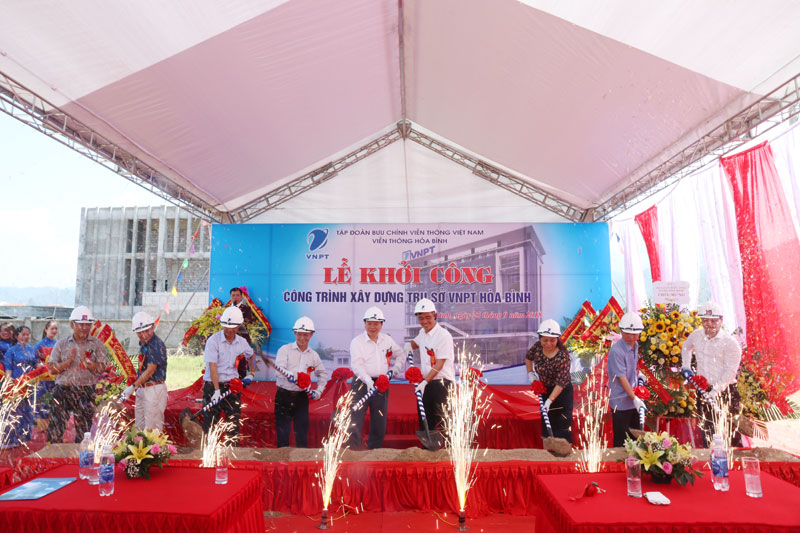
(HBO) - On the morning of September 25th, Hoa Binh Telecommunications Company (VNPT Hoa Binh) held a commencement ceremony to start building a new head office.

The leaders of the province, the Vietnam
Posts and Telecommunications Group and other departments of the province
participated in the commencement ceremony of the project of building the
working office for VNPT Hoa Binh.
Attending the commencement ceremony, there
were Mr. Nguyen Van Chuong, the Vice Chairman of the provincial People's
Committee and the leaders of Vietnam Posts and Telecommunications Group; the
representatives from departments, sectors, partners, etc.
At 9.30a.m, the representative of VNPT Hoa
Binh delivered a speech and issued the order to commence the office building
construction of VNPT Hoa Binh Office.
The Head Office of VNPT Hoa Binh is being
built on the location netx to Hoa Binh Square, belonging to the area of Su Ngoi
commune (Hoa Binh city). The project is located on the main road in the area
with many units and administrative agencies of the province being formed and
developed.
According to the design, the building of VNPT
Hoa Binh has a scale of 7 floors and a basement (garage) on a building area of
about 650m2. The total floor area in use is about 5,650 m2, in which the floor
area of working, transaction, etc. is about 5,000 m2 and the basement
construction area is about 650m2. The total investment of the project is nearly
76 billion VND, and the project is expected to be completed in 2020.
This project aims to create material facility
to meet the demand of working offices, operating the production and business
activities, dealing with customers of VNPT Hoa Binh. It contributes to building
up the brand name and image of VNPT in the locality, while it facilitates the
development of infrastructure and provision of Telecommunications and IT
services for departments and agencies in Hoa Binh province.
With a professional, enthusiastic staff team
and potential development, the construction of VNPT Hoa Binh building office is
a new milestone marking for the non-stop development of units in the period of
integration and development.
Hoa Binh province is undergoing a dynamic transformation amid Vietnam’s national digital transition. Building on Poliburo’s Resolution No. 57-NQ/TW on breakthroughs in science, technology, innovation, and national digital transformation, the province has rolled out a wide range of practical action plans. A standout initiative is the "Digital Literacy for All” movement, an effort to ensure that no one is left behind in the digital era.
Hoa Binh province is undergoing a dynamic transformation in the wake of the national digital transformation movement. Building on Resolution No. 57-NQ/TW of the Politburo on breakthroughs in science, technology, innovation, and national digital transformation, the province has implemented a wide range of practical action plans. A standout initiative is the "Digital Literacy for All” movement ambitious effort to ensure that no one is left behind in the digital age.
With a spirit of unity and proactive problem-solving, the Party Committee, the government and the people of Dong Lai Commune (Tan Lac District) have made great strides in implementing the resolutions of the 24th Party Congress of the commune for the 2020 - 2025 term. Focusing on leadership and practical actions, the commune has brought the Party’s resolutions into daily life, creating strong impacts and pushing the local development forward.
Amid the nationwide push for digital transformation, young people in Hoa Binh Province are stepping up as dynamic pioneers, applying technology to enhance Youth Union operations and expand the reach of youth-led initiatives. Through creativity and adaptability, Youth Union organizations at all levels have introduced a series of practical solutions, contributing to modern governance and community development.
In recent years, An Nghia commune, located in Lac Son district, has stepped up administrative reform, focusing on improving the quality and efficiency of its single-window service unit for receiving and processing administrative procedures. These improvements have helped create favourable conditions for local residents and organisations to handle administrative procedures, contributing to the commune’s broader socio-economic development.
The Prime Minister-approved master plan to develop the multi-use value of forests ecosystems through 2030, with a vision to 2050, aims to improve the management and sustainable use of forest resources, create jobs, increase incomes, and improve the living standards of ethnic minorities, people in mountainous and remote areas, forest workers and those living near forests.



